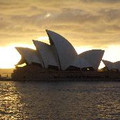的点评
Freedom rings: balanced overview of an iconic national treasure.
自由钟中心的点评
点评:It is a fitting, if not metaphorical beginning that the Liberty Bell was initially made in England at a London firm and then recast (twice!) in Philadelphia after the initial product was deemed unsatisfactory. Once the “final” version of the bell was complete, it was hung in 1753 in the bell tower at the Pennsylvania State House. Although there is no evidence the bell was rung on July 4, 1776 it probably sounded four days later when the Declaration of Independence was first read to the public. After making a brief trip to Allentown as the British approached Philadelphia, the bell returned to the State House and developed its iconic fissure in the first half of the 19th century; by the second half of the same it’s fame increased to the point of national legend. The rest, as they say, is history… in this case with a healthy dose of myth. After tours of the US in the early 1900’s, the national icon has been permanently housed at its current location in the Liberty Bell Center since 2003. Admission is, appropriately, free.
The entrance to the building is logically located just south of the Independence Visitor Center and starts with a modern-but-necessary inconvenience: a security check. After this there are two components to the experience: a small museum about the Liberty Bell and the bell itself. The museum is a static, vaguely chronologic affair. It starts with a detailed technical history of the bell and a description of the signature crack. The role of the bell in the Revolutionary War was followed by descriptions of its post-conflict tours of the country. The hypocrisy of liberty, freedom, and equality was also addressed, most notably in making connections to the Women’s Suffrage and Civil Rights movements. A fifteen-minute movie rounds out the didactic portion of the visit. The Liberty Bell itself is fittingly cloistered at the end in an alcove, with a window displaying Independence Hall in the background.
In conclusion, this was a well-presented historical artifact that dovetails geographically (it’s a stone’s throw away) and chronologically with Independence Hall. The bell itself was presented with the appropriate amount of digital window dressing (i.e. none) and was perfectly placed. The museum was brief but managed to address the historical complexities of the Liberty Bell’s story in a balanced way. As usual, the Park Rangers were professional, knowledgeable, and courteous. One could easily manage a visit here and to Independence Hall in a single day, checking off two national “must-see” sights. Thumbs up.
The entrance to the building is logically located just south of the Independence Visitor Center and starts with a modern-but-necessary inconvenience: a security check. After this there are two components to the experience: a small museum about the Liberty Bell and the bell itself. The museum is a static, vaguely chronologic affair. It starts with a detailed technical history of the bell and a description of the signature crack. The role of the bell in the Revolutionary War was followed by descriptions of its post-conflict tours of the country. The hypocrisy of liberty, freedom, and equality was also addressed, most notably in making connections to the Women’s Suffrage and Civil Rights movements. A fifteen-minute movie rounds out the didactic portion of the visit. The Liberty Bell itself is fittingly cloistered at the end in an alcove, with a window displaying Independence Hall in the background.
In conclusion, this was a well-presented historical artifact that dovetails geographically (it’s a stone’s throw away) and chronologically with Independence Hall. The bell itself was presented with the appropriate amount of digital window dressing (i.e. none) and was perfectly placed. The museum was brief but managed to address the historical complexities of the Liberty Bell’s story in a balanced way. As usual, the Park Rangers were professional, knowledgeable, and courteous. One could easily manage a visit here and to Independence Hall in a single day, checking off two national “must-see” sights. Thumbs up.
翻译:自由钟最初是在英国的一家伦敦公司制造的,由于初版产品不尽人意,后来在费城重铸(两次!),这是一个恰当的开头,即使不是隐喻性的开头。当“最终”版本的钟完成后,它于 1753 年悬挂在宾夕法尼亚州议会大厦的钟楼上。虽然没有证据表明这口钟是在 1776 年 7 月 4 日敲响的,但它很可能是在四天后《独立宣言》首次向公众宣读时敲响的。在英国人接近费城时,这口钟短暂地流向了阿伦敦,之后又回到了州议会大厦,并在 19 世纪上半叶形成了标志性的裂痕;到 19 世纪下半叶,它的名气越来越大,成为了全国传奇。剩下的,正如人们所说,都是历史了……在这种情况下,还带有大量的神话色彩。在 20 世纪初美国进行过巡回参观后,这个国家象征自 2003 年以来就永久安置在了自由钟中心的现址。入场是免费的,这是理所当然的。
大楼的入口位于独立游客中心的正南方,首先要经过一个现代但必要的不便:安全检查。之后,体验分为两个部分:一个关于自由钟的小型博物馆和自由钟本身。博物馆是一个静态的、模糊的时间顺序的展览。它以钟的详细技术历史和标志性裂缝的描述开始。钟在独立战争中的作用之后,是它在战后在美国巡回演出的描述。自由、自由和平等的虚伪也得到了解决,最引人注目的是与妇女选举权和民权运动的联系。一部 15 分钟的电影结束了这次参观的教育部分。自由钟本身恰如其分地隐藏在壁龛的末端,背景中有一扇展示独立厅的窗户。
总之,这是一件展示良好的历史文物,在地理位置(近在咫尺)和时间顺序上与独立厅相吻合。钟本身的数字橱窗装饰数量适中(即没有),位置也恰到好处。博物馆很简短,但设法以平衡的方式解决了自由钟故事的历史复杂性。像往常一样,公园管理员很专业、知识渊博、彬彬有礼。人们可以轻松地在一天内参观这里和独立厅,完成两个国家“必看”景点。竖起大拇指。
大楼的入口位于独立游客中心的正南方,首先要经过一个现代但必要的不便:安全检查。之后,体验分为两个部分:一个关于自由钟的小型博物馆和自由钟本身。博物馆是一个静态的、模糊的时间顺序的展览。它以钟的详细技术历史和标志性裂缝的描述开始。钟在独立战争中的作用之后,是它在战后在美国巡回演出的描述。自由、自由和平等的虚伪也得到了解决,最引人注目的是与妇女选举权和民权运动的联系。一部 15 分钟的电影结束了这次参观的教育部分。自由钟本身恰如其分地隐藏在壁龛的末端,背景中有一扇展示独立厅的窗户。
总之,这是一件展示良好的历史文物,在地理位置(近在咫尺)和时间顺序上与独立厅相吻合。钟本身的数字橱窗装饰数量适中(即没有),位置也恰到好处。博物馆很简短,但设法以平衡的方式解决了自由钟故事的历史复杂性。像往常一样,公园管理员很专业、知识渊博、彬彬有礼。人们可以轻松地在一天内参观这里和独立厅,完成两个国家“必看”景点。竖起大拇指。



此点评仅代表旅行者个人的主观意见,并不代表TripAdvisor以及其合作方的意见。
关于我们
|新闻动态
|商务合作
|会员中心
|业主中心
|常见问题
|意见反馈
|联系我们
|营业执照
© 2025 Tripadvisor 版权所有。
使用条款 |隐私政策 |网站工作原理
部分照片由 VFM Leonardo 提供。
* Tripadvisor不是旅行社,也不是旅游预订服务代理商。我们提供免费、客观、公正的旅游资讯服务。 (显示更多)
TripAdvisor LLC 既不是预订代理商,也不是旅游运营商,不会向网站用户收取任何服务费。 按照规定,在 Tripadvisor 发布机票价格、游览和旅行套餐的合作伙伴(航空公司、旅行提供商及预订代理商),其标价须包含所有费用和附加费用。 例如, 机场出入境税费、消费税与其他服务费、手续费、杂费及附加费用。 当您向我们的某个合作伙伴进行预订时,请务必查阅他们的网站以了解当地行政部门要求的所有适用费用的具体情况。 除非另有说明,机票价格通常指的是一个人的价格(以人民币计)。
为方便起见,TripAdvisor LLC 根据从我们的预订合作伙伴获取的空房率计算每个酒店的均价。 对于游览和景点来说,所显示价格通常是每位成人的最低可用价格。 对于列出的任何旅行套餐或优惠,TripAdvisor LLC 无法保证任何特定的费率或价格。 此外,酒店均价每晚会更新,并以您的首选币种表示(使用现行汇率)。 由于这些已换算的价格是预估价格,因此,有关具体金额和币种请与预订网站进行核实。
此外,TripAdvisor LLC 无法保证我们网站上宣传的价格随时有效。 标价可能需要预订一定天数才能生效,或有不可用日期、使用条件或限制。
TripAdvisor公司对外部网站的内容一概不负责。优惠价格中不含税和其他费用。
ICP证:沪B2-20200433
沪ICP备20013175号
 沪公网安备31010502005427号
沪公网安备31010502005427号鹰程信息技术(上海)有限公司
货币/国家及地区
¥CNY
中国

